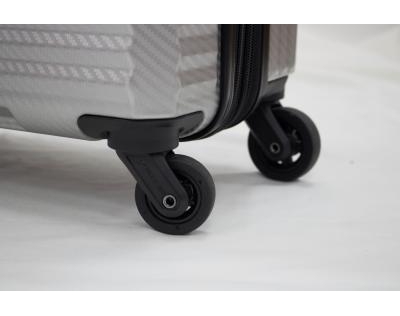Understanding the key features of Polycarbonate and ABS Hard Shell
Choosing the right luggage is always a tough one. Currently, the luggage styles on the market are different, the materials are different, and even the subdivision of the use, commercial use, travel use, and moving use. In this article, we will focus more on materials, which are most common in hard luggage industry - Polycarbonate and ABS.
Polycarbonate is more flexible than ABS and has a higher impact resistance. As a result, it makes for a stronger suitcase. ABS suitcases are cheaper than Polycarbonate ones, but they are often heavier and do not last as long.
Here are even more details about each material.
Polycarbonates
Polycarbonates (PC) are a group of thermoplastic polymers containing carbonate groups in their chemical structures. Polycarbonates used in engineering are strong, tough materials, and some grades are optically transparent. They are easily worked, molded, and thermoformed. Because of these properties, polycarbonates become the ideal material for hardside luggage. It also has high degree of hardness and impact resistance making for durable luggage. Polycarbonate is also highly temperature resistant and has some nice self-extinguishing properties. All good things for luggage, right?
This also means it can be moulded pretty easily into different luggage shapes, making it very flexible and able to take a beating during travel.
Moreover, Polycarbonate is so popular thanks to its low weight ratio. It can bend and dent and will easily go back to its original shape. It is almost impossible to break and has the highest level of strength of all luggage materials.
ABS
ABS is a mixture of three kinds of plastics, each with their own unique characteristics:
- Acrylonitrile provides chemical and fatigue resistance, hardness, and melt strength.
- Butadiene provides good impact resistance.
- Styrene provides heat resistance, processability, color and hardness
Together, ABS is great for impact resistance (ie. luggage handlers), easier processing (making into shapes) and has great mechanical properties: high heat distortion temperature, and gloss property.
This makes ABS ideal for a broad field of applications, including piping and fittings, instrument and appliance housings, tool housings such as hand drills, electric screw drivers, automotive instrument panels and home appliances.
In luggage, ABS is the cheapest hard material used. It's also very light and makes ABS luggage cheaper than most, but unfortunately it's also not the most durable. For most luggage makers, however, they use ABS combined with other materials to make a stronger suitcase overall. Be on the lookout for this in the product descriptions or specifications.
So which is the right luggage for you?
Understanding the differences between ABS and PC, we - Trimmers always investigate and consult customers to choose the best materials for their products. For instance, the best choice will be Polycarbonate for a frequent traveler. It will be a complete waste of money if invested in pure ABS luggage as chances will be high to make replacement very often. ABS and polypropylene luggage for kids can be a good choice but not for adults for frequent traveling.
Currently, we produce bottom compartment mainly used PC plastic, which gives more durability for any luggage. You may be interested in our series - Locomo and Akita.
There really is no best material for any one piece of luggage. The important thing is that you undestand demands and needs of your end-customers, and we are here to help you to make best iconic luggage for your brand.












